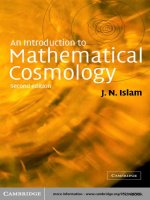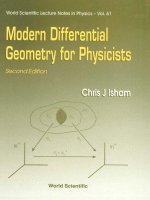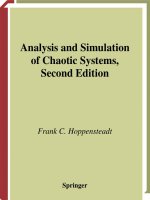- Trang chủ >>
- Khoa Học Tự Nhiên >>
- Vật lý
Statistical thermodynamics 2nd ed 4255
Bạn đang xem bản rút gọn của tài liệu. Xem và tải ngay bản đầy đủ của tài liệu tại đây (5.7 MB, 96 trang )
STATISTICAL
THERMODYNAMICS'
A. Course of Seminar Lectures
DELIVERED IN
j
ANU .A,RY-MA.ROH 1944, AT THE
SOHOOL OF THEORETIOA.L PHYSIOS, DUBLIN INSTITUTE FOR
A.DVANOED STUDIES
BY
ERWIN SCHRODINGER
CAMBRIDGE
AT THE UNIVERSITY PRESS
1948
IIA
Lib~
Printed in Great Britain at the University Pres8, Oambridge
(Brooke Orutchley, University Printer)
and published by the Oambridge University Pre88
(Oambridge, and Bentley House, London)
Agents for U.S.A., Oanada, and India: Macmillan
Firat j'dition 1946
Repr'inted 1948
CONTENTS
Ohapter
I. General introduction.
page 1
•
',.
II. The method of the most probable distribution •
5
III. Discussion of the Nernst theorem
15
IV. Examples on the second section
18
(a) Free mass-point (ideal monatomic gas)
19
(b) Planck's oscillator
20
.
(c) Fermi oscillator
•
V. Fluctuations
22
•
VI. The method of mean values
VII. The n-particle problem
20
27
42
•
VIII. Evaluation of the formulae. Limiting cases
53
The entropy constant
56
The failure of the classical
. theory . Gibbs's
paradox
58
Digression: Annihilation of matter ~
•
62
Digression on the uncertainty relation .
64
Gas-degeneration proper
67
Weak degeneration
68
.
.
Medium degeneration
Strong degeneration
(a) Strong Fermi-Dirac degeneration
(b)
Strong Bose-Einstein degeneration
IX. The problem of radiation .
69
70
70
76 '
81
NOTE
Aver~ ~mall eaition of tne~e Lectures was puoli~h~d
in necto~ra~h form bJ tn6 Dublin Institute for
Aavan~ea ~tuQie~, It i~ no~eQ that the ~re8ent
eilition, for whien the text 1M oeen 8u~htly revisea, .
ma~ reach amaer ckcl~ of reaaer~,
t
CHAPTER
I
GENERAL INTRODUCTION
object of this seminar is to develop briefly one simple,
unified standard method, capable of dealing, without changing
the fundamental attitude, with all cases (classical, quantum,
Bose-Einstein, Fermi-Dirac, etc.) and with every new problem
that may arise. The interest is focused on the general procedure,
and examples are dealt with as illustrations thereof. It is not a
first introduction for newcomers to the subject, but rather a
'repetitorium '. The treatment of those topics which are to be
found in everyone of a hundred text~ books is severely condensed;
on the other hand, vital points vvhich are usually passed over in
all but the large monographs (such as Fowler's and Tolman's)
are dealt with at greater length.
There is, essentially, only one problem in statistical thermodynamics: the distribution of a given· amount of energy E over N
identical systems. Or perhaps better: to determine the distribution of an assembly of N identical systems over the possible
states in which this assembly can find itself, given that the
energy of the asseln hIy is a constant E. The idea is that there is
weak interaction between them, so weak that the energy of
interaction can be disregarded, that one oan speak of the
'private' energy of everyone of them and that the sum of their
, private' energies has to equal E. The distinguished role of
the energy is, therefore, simply that it is a constant of the
motion-the one that always exists, and, in general, the only
one. The generalization to the case, that there are others besides
(momenta, moments of momentum), is obvious; it has occasionally been contemplated, but in terrestrial, as opposed to astrophysical, thermodynamics it has hitherto not acquired any
importance.
THE
SST
2
STATISTIOAL THERMODYNAMICS
'To determine the distribution' means in principle to make
oneself familiar with any possible distribution-of-the~energy
, (or state-of-the-assembly), to classify them in a suitable way,
i.e. in the way suiting the purpose in question and to count the
numbers in the classes, so as to be able to judge of the probability of certain features or cha,racteristics turning up in the
assembly. The questions that can arise in this respect are of the
most varied nature, and so the classification really needed in a
special problem can be of the most varied nature, especially in
relation to the fineness of classification. At one end of the scale
we have the general question of finding out those features which
are common to almost all possible states of the assembly so that
we may safely contend that they 'almost always' obtain. In
this case we have well-nigh only one class-actually two, but
the second one has a negligibly small content. At the other end
of the scale we have such a detailed question as: volume ( = number of states of the assembly) of the' class' in which one individual member is in a particular one of its states. Maxwell's
law of velocity distribution is the best-known example.
This is the mathematical problem-always the same; we shall
soon present its general solution, from which in the case of every
particular kind of system every particular classification that
may be desirable can be found as a special case.
But there are two different attitudes as regards the physical
application of the mathematical result. We shall later, for
obvious reasons, decidedly favour one of them; for the moment,
we must explain them both.
The older and more naive application is to N actually existing
physical systems in actual physical interaction with each other,
e.g. gas molecules or electrons or Planck oscillators or degrees
of freedom (' ether oscillators ') of a 'hohlraum'. The N of them
together represent the actual physical system under consideration. This original point of view is associated with the names of
Maxwell, Boltzmann and others.
But it suffices only for dealing with a very restricted class of
GENERAL INTRODUCTION
3
physical systems-virtually only with gases. It is not applicable
to a system which does not consist of a great number of identical
constituents with (private' energies. In a solid the interactiqn
between neighbouring atoms is so strong that you cannot
•
mentally divide up its total energy into the private energies
of its atoms. And even a 'hohlraum' (an' ether block' considered
as the seat of electromagnetic-field events) can only be resolved
into oscillators of many-infinitely many-different types, so
that it would be necessary at least to deal with an assembly of
an infinite number of different assemblies, composed of different
constituents.
Hence a second point of view (or,rather,adifferent application
of the same mathematical results), which we owe to Willard
Gibbs, has been developed . It has a particular beauty of its
own, is applicable quite generally to every physical system,
and has some advantages to be mentioned forthwith. Here the
N identical systems are mental copies of the one system under
consideration-of the one macroscopic device that is actually
erected on our laboratory table. Now what on earth could it
mean, physically, to distribute a given amount of energy E
over these N mental copies ~ The idea is, in my view, that you
can, of course, imagine that you really had N copies of your
system, that they really were in 'weak interaction' with each
other, but isolated from the rest of the world. Fixing your
attention on one of them, you find it in a peculiar kind of
'heat-bath' which consists of the N-l others.
Now you have, on the one hand, the experience that in thermodynamical equilibrium the behaviour of a physical system which
you place in a heat-bath is always the same whatever be the
nature of the heat-bath that keeps it at constant temperature,
provided, of course, that the bath is chemically neutral towards
your system, i.e. that there is nothing else but heat exchange
between them. On the other hand, the statistical calculations
do not refer to the mechanism of interaction; they only assume
that it is 'purely mechanical') that it does not affect the nature
4
STATISTICAL THERMODYNAMICS
of the single systems (e.g. that it never blows them to pieces),
but merely transfers energy from one to the other.
These considerations suggest that we may regard the behaviour of anyone of those N systems as describing the one
actually existing system when plaoed in a heat-bath of given
temperature. Moreover, since the N systems are alike and under
similar conditions, we can then obviously, from their simultaneous statistics, judge of the probability of finding our system,
when placed in a heat-bath of given temperature, in one or other
of its private states. Hence all questions concerning the system
in a heat-bath can be ans,vered.
We adopt this point of view in principle-though all the
following considerations may, with due care, also be applied'to
the other. The advantage consists not only in the general applicability, but also in the following two points:
(i) N can be made arbitrarily large. In fact, in case of doubt,
we always mean limN = 00 (infinitely large heat-bath). Hence
the applicability, for example, of Stirling's formula for N 1, or
for the factorials of 'occupation numbers' proportioIl;al to N
(and thus going with N to infinity), need never be questioned.
(ii) No question about the individuality of the members of
the assembly can ever arise-as it does, according to the 'ne\v
statistics!' , with particles. Our systems are macroscopic systems,
which we could, in principle, furnish with labels. Thus two states
of the assembly differing by system No.6 and system No. 13
having exchanged their roles are, of course, to be counted as
different states-while the same may not be true when two
similar atoms within system No.6 have exchanged their roles;
but the latter is merely a question of enumerating correctly the
states of the single system, of describing correctly its quantummechanical nature ..
CHAPTER
II
THE METHOD OF THE MOST PROBABLE
DISTRIBUTION
WE are faced with an assembly of N identical systems. We
describe the nature of anyone of them by enumerating its possible states, which we labell, 2, 3, 4, .' *' l, .... In principle we
have always in mind a quantum-mechanical system whereby
the states are to be described by the eigenvalues of a complete
set of commuting variables. The eigenvalues of the energy in
these states we call 61 , c2' cs, ••• , 6z, ••• , ordered so that 6,+1 ~ e1But, if necessity arises, the scheme can also be"applied to a 'classical system' , when the states will have to he described as cells in
phase-space (Pk, q,r,) of equal volume and-whether infinitesimal
in all directions or not-at any rate such that the energy does
not vary appreciably within a cell. More important than this
merely casual application is the following:
We shall always regard the state of the assembly as determined by the indication that system ,No.1 is in state, say, lv
No.2 in state l2' .•• , No. N in state IN- We shall adhere to this,
though the attitude is altogether wrong. For, a, quantummechanical systelu is not in this or that etate to be described by
a cOlnplete set ofnon-conlmuting variables chosen once and for
all. To adopt this view is to think along severely' classical' lines.
With the set of states chosen, the individual systeln can, at
best, be relied upon as having a certain probability amplitude,
and so a certain probability, of being, on inspection, found in
state No.1 or No.2 or No.3, etc. I said: at best a probability
amplitude. Not even tha-t much of determination of the single
system need there be . Indeed, there is no clear-cut argument for
attributing to the single system a .: pure state' at all.
If we were to enter on this argument, it would lead us far
astray to very subtle quantum-mechanical considerations.
6
STATISTIOAL THERMODYNAMICS
Von Neumann, Wigner and others have done so, but the.results
do not differ appreciably from those obtained from the simpler
and more naive point of view, which we have outlined above
and now adopt.
Thus, a certain class of states of the assembly will be indicated
by saying that a1 , a 2 , as, .. _, az; ... of the N systems are in state
1,2,3, ... , l, .... respectively, and all states of the assembly are
embraced-without overlapping-by the classes described by
all different admissible sets of numbers a~:
State No.
I
2 3 ... . l ....
Energy
61
62
8's
•••
6z
(2·1)
Occupation No. a 1 az as
at ...
The number of single states, belonging to this class, is ob ..
viously
. N!
P
= a ,• a
t
I
Z
2 • as'
,.
(2-2)
... - a z· -..
The set of numbers a"IDust, of course, comply ,vith the conditions
~a,=N,
~elat=E.
(2-3)
1
1
The statements (2·2) and (2·3) really finish our counting. But
in this form the result is wholly unsurveyable.
The present method admits that, on account of the enormous
largeness of the number N, the total number of distributions
(Le. the sum of all P's) is very nearly exhausted by the sum of
those P's whose number sets az do not deviate appreciably from
that set which gives P its maximum value (among those, of
course, which oomply with (2-3)). In other words, if we rega,rd
this set of occupation numbers as obtaining always, we disregard only a very small fraction of all possible distributions
-and this has 'a vanishing likelihood of ever being realized' .
This assumption is rigorously correct in the limit N -?- co
(thus: in the application to the 'mental' or 'virtual' assembly,
where in dubio we always m.ean this limiting case, which corresponds physically to an 'infinite heat-bath'; you see again the
great superiority of the Gibbs point of view). Here we adopt this
METHOD OF PROBABLE DISTRIBUTION
7
assumption without the proof which will emerge later from the
alternative method-the Dar,vin-Fowler 'luethod of mean
values' .
For N large, but finite, the assumption is only approximately
true. Indeed, in the application to the Boltzlnann case, the
distributions with occupation numbers deviating from the
'maximum set' must not be entirely disregarded. They give
information on the thermodynamic fluctuations of the Boltzmann system, '\vhen kept at constant energy E, i.e. in perfect
heat isolation.
But we shall not work that out here, partly on account of the
very restricted applicability of the Boltzmann point of view
itself, and also for the following reason: Since the condition of
perfect heat isolation cannot be practically realized, the results
obtained for the thermodynamic fluctuations under this, nonrealizable, condition apply to reality only in part, that is, in so
far as they can be shown to be, or can be trusted to be, the same
. as 'under heat.bath condition'. Now the fluctuations of a
system in a heat-bath at constant ternperature are nluch more
easily obtained directly from the Gibbs point of view. Hence
there is no point in following up the more complicated device to
obtain information which really only applies to an ideal;» nonrealizable, case.
Returning to (2·2) and (2-3), ,ve choose the logarithlu of P
as the function whose maximum we determine, taking care of
the accessory conditions in the usual way by Lagrange multipliers, A and It; i.e. we seek the unconditional maxiInum of
log P- A ::E az-fA- ::E eZal;
(2·4)
l
l
for the logt1rithms of the factorials we use Stirling's formula in
the form
log (n!) = n(log n -1).
(2·5)
And, of course, we treat the az as though they were continuous
variables. We get for the variation of (2,4)
- ::E loga~Sal-i\ ::E taz-j-t
l
l
~ eltaZ
l
= 0,
8
" STATISTICAL THERMODYNAMICS
and have to equate to nought the coefficients of every 8az, thus
(for every l)
logaz+A+ }tel = 0,
a~ =
or
e-'A-P6 z.
A and. fl are to be determined from the accessory conditions, thus
~ e-A-pez = N,
~ 6ze-J...-pel = E.
l
l
On dividing, member by member, we eliminate A, but we can
also obtain e-'A direct~y from the first formula. Calling E / N = U
the average share of energy of one system, we express our
whole result thus:
8
-NE = U = Eeze-ft6,
= --logIe-pel
Ie-pel
8p
,
(2-6)
The set of equations in the second line indicates the distribution
of our N systems over their energy levels. It may be said to
contain, in a nutshell, the whole of thermodynamics, which
hinges entirely on this basic distribution. The relation itself is
very perspicuous-the exponential e-pe l indicates the occupation
number az as a fraction of the total number N of systems, the
sum in the denominator being only a 'normalizing factor'. But,
of course, ft would have to be determined from the first equation
as a function of the average energy U and the 'nature of the
system' (i.e. the €z's); and, naturally, it is impossible to solve
this equation generally with respect to ft. In fact, it is obvious
that the functional dependence between jt and U is certainly
not universal, but depends entirely on the nature of the system.
But very fortunately we can give to our relations a very
satisfactory general physical interpretation, without solving
that equation with respect to p, because the latter (originally
introduced just as a Lagrange multiplier, as a mathematical
help) turns out to be a much more fundamental quantity than
U; so much so, that the physicist is gratified to be given, in
METHOD OF PROBABLE DISTRIBUTION
9
every particular case, U as a function of it, rather than vice
versa, which would be quite unnatural.
To explain this without too many qualifications, we now
definitively adopt the Gibbs point of view, namelY7 that we are
dealing with a virtual ensemble, of which the single member is
the system really under consideration. And since all the single
members are of equal right, we may now, when it comes to
physical interpretation, think of the az' or rather of the azlN,
as the frequencies with which a single system, immersed in a
large heat-bath, will be encountered in the state 8z, while U is
its average energy under these circumstances.
We now apply our results (2-6) to three different (assemblies
of) systems, viz_
A+B,
levels:
6,
}
= a7c+ Pm.
By this we mean that in the first and in the second case the
single members sha'!l be any two different systenls of the
general type considered hitherto, while in the third case the
singie Ine:.;n ber shall consist of one system A and one system B
put into loose energy contact, so that the general energy level
in the third case is the sum of any ak and any Pm (the index t
standingteally for the pair of indices (lc, lIn)). A moment's consideration shows that in the third case the stun splits into a
product of two sums, th"ll:s:
:.E e-ttCl ==
Z
~ ~ e-p(a,,+/im)
k 'm
= ::E e-PCtk :E e-p.Pm •
k
(2·8)
rn
Hence froIn (2-6)-always in this third case-the general
occupation number ell (which we may equivalently label a(lc.m»
reads
(2-9)
We continue to speak of the third case and inquire, what is the
number of systems' A + B' with A on the particular level a7e ~
It is clearly found on sumlning (2'U) over all m. In the result the
10
STATISTICAL TI-IERMODYNAMICS
Ee-PP cancels in numerator and denominator and we are left with
It is thus seen that the entire st~\Jtistical distribution of the A
systems in the third case (including inter multa alia the mean
value of their energy) is exactly the same as it would be in an
A assembly (first case) provided that we arrange (by a suitable
choice of EjN in the..A case) for the value of p to be the same in
the two cases.
Since the same consideration applies to system B, we have,
according to our interpretation, that if you put the systems
A and B into loose contact with one another and put them
in a heat-bath, each of them behaves exactly as it would
when put into a heat-bath by itself, provided only that the
three heat-baths are chosen so as to make the p values equal in
the three cases. In other words, if that is done, the established
energy contact is idle and there is, on the average, no mutual
influence or energy exchange.
This can hardly be interpreted otherwise than that equal p.
means equal temperature. And since you can choose a standard
system A once and for all (' thermometer ') and put it into contact
with any other system B, J.t must be a universal function of the
temperature T.
This conclusion will be considerably strengthened when we
proceed to determine explicitly what function of the temperature
fo
.
IS.
For this purpose it is well to take stock of an obvious but very
important by-product of our preceding considerations. We have
seen that in the' A + B' case the
~ e-pe z =
Z
~ e-PtXk ~ e-PPm •
k
m
Hence the function of p) which we shall see to be very important,
.
VIZ.
(2-10)
METHOD OF PROBABLE DISTRIBUTION
11
(whose usefulness is clear from the last members of (2 . 6» is
additive for two systems in loose energy contact. That is the
obvious, but relevant, statement to which I referred above_
Now what is the functional relation between # and T~ To
tell the 'true' absolute temperature T from the lot of its monotonic functionsf( T), there is, as is well known, only one criterion:
lIT is a universal integrating factor of the infinitesimal heat
supply dQ in thermodynamic equilibrium-universal, that is to
say, for any system. No other function of T has this propertyit is the definition of T (Kelvin).
To avail ourselves of this definition, our model is still inadequate. For, with th~ 'nature' of every system (i.e. its
levels ez) fixed once and for all, everything depends on one parameter, p or U-,or T. With a single variable the notion of
'integrating factor' collapses, for with ax, any ¢(x) ax is also
'a complete differential'. Hence, to identify T, we must introduce the notion of other parameters or, what is the same thing,
the notion of mechanical work done by the system.
Let us put, for the sake of brevity,
= F,
(2·11)
z
which is to be regarded as a function of p and all the 6z'S; and let
us write down, using (2-6), an undoubtedly correct mathematical relation, of which the physical applictttion will follow
presently:
of
of
dF = -dp+ ~--dez
01"
z eel
log
~ e-j.l£,
=-Udp-;7a~del'
and thus
(2-12)
(2-13)
,
We apply this to the following physical process, to whioh we
subject our assembly of N systems.
We assume that each of them has identically the same
'mechanism' attaohed to it, screws, pistons and what not, which
12
STATISTICAL THERMODYNAMICS
we oan handle and thereby change its nature (Le_ the levels ez).
We do so, changing; of course, the e/s for all of them alike in
order that the basic condition of l! identical systems, on which
all our reasoning rests, shall be nlaintained. In addition, we also
procure a direct 'change of temperature', by Coupling our
assembly with a large heat-bath (of the same temperature),
changing the temperature of the whole very slightly and then
isolating the assembly again from the heat-bath.
When (2·13) is applied to this process, azdezis the work we have
to do on the pistons, etc., attached to those a z systclns in order
to 'lift them up' from the old level 6z to the altered level ez+ del;
.Ea1.de, is the work done in this way on the asselnbly, -Eazdel
the work done by the assembly, and -
j
L:a,de , the average work
done by one of the members. And hence, since dU is its average
energy increase, the round bracket to the right of (2-13) must
be the average heat supply dQ supplied to it. p, is seen to be ~~n
integrating factor thereof. This alone really sufIlces to say thu,t
# must be essentially liT, because there is no oth.er functio:Il.
of T which has this property for every systern. And so ]j'+ Ull
must be, essentially, the entropy_
To give a more direct proof, call
=
F+ U#
O.
(2-14)
Then, from a general mathematical theorenl, the ratio of tIle
two integrating factors lIT and p is a function of G:
1
Tp
= ¢(G) say.
Hence from (2-13)
(2-15)
dQ
1>(G) dO =
T
= dB,
(2·1t»
where S is the entropy. This, on integration, yields G as sonle
function of S, say
,G = X(S).
Now from (2-14), (2·11) and (2·6)
G
= log "'Z e-j1..el Z
8
f l - log ~ e-j1..ez
aft
l
METHOD OF PROBABLE DISTRIBUTION
13
'behaves additively' when two systelns are combined (since
logEe-pez does). Calling the X function of (2-17) XA. in the case
of a system A, 'XB for a system Band XAB for the combined
system 'A + B " and calling the entropies in these three cases
S.A.' BB and S.I1B respectively, we have
XA.(S..4.) + XB(SB) = X.A.B(BAB )·
On the other hand, the entropy, too, is an additive function, or
at any rate
where
a is independent of S..4. and S B-
Hence
XA(SA)+XB(SB) =XAB(S.A+SB+O).
If you differentiate this equation once with respect to SA' and
again with respect to S B' and compare the results, you get
X~(SA)
=
XB(BB) = universal constant
= 11k (say).
Thus, from (2·17), (2·16) and (2,15)
1
(2-18)
p= kT
and
S
=
kG+const. = klog
~e-e,/lcT+
U
p+const.,
(2,19)
where the const. is aft any rate independent of T and- of the
'parameters' (as volume, etc.) on which the ez's depend.
We drop the' const.' , pending an analysis of what that means.
Then we have
U
k log ~ e-ezl7c'l = S - T = P.
(2·20)
"f
\Ve have thus obtained a general prescription-applicable to all
cases (including the so-called 'new' statistics)-for obtaining
the therlnodynamics of a system from its mechanics.
Form the 'partition function' (also called 'sum-over-states';
German Zustand8surlLme)
Z = ~e-ellkT.
(2·21)
z
Then k log Z (where k is the Boltzmann constant) is the negative
14
STATISTICAL THERMODYNAMICS
free energy, divided by T (with Planck we have introduced the
letter Pfor this function). From the comments made on (2-13)
it is easily seen that our k log Z is the thermodynamical 'P function in every respeot, not only for changes of temperature but
also for changes of the parameters (as, for example, the volume
V) on which the 61, may depend. Thus the average forces with
which the system' tends to increase these parameters' (e.g. the
pressure p, in the case of the parameter volume) are found by
the formulae familiar from thermodynamics, the pro~otype
being
8P
8
(2-22)
p = T BV = kT 8V1og ~e-ellkT,
while the first equation (2-6),
u
= -
8
8p log
7e-
P€1
=
alP
T2 aT'
(2,23)
is an equally well-Known formula of general thermodynamics
(in all this lJI is to be regarded as a function of T and such
parameters as V, on which the 6 l may depend; maoroscopioally
these parameters must fulfil the requirement, that when they
are kept oonstant the system does no mechanical work*). Thus
the statistical treatment, by yielding in principle lP as a funotion
of T and the parameters like V, yields exhaustive information
on the thermodynamical behaviour. (It is well known that a
certain th.ermodynamical function yields complete information
o~y when known as a function of certain variables. Fo~ example, P(T,p, ... ) -or S(T, V, ... ) does not, but, for example,
S(U, V, ... ) does.)
* Against
the treatment given here it could be objected that
experimentally it is just as impracticable to keep such paralneters
as V exactly constant as to realize a complete heat isolation.
A statistical treatment which introduces instead of the V's rather
the quantities like p as parameters is perfectly possible, perhaps
preferable, but considerably more complicated.
CHAPTER
III
DISCUSSION OF THE NERNST THEOREM
WE turn to the question of what it means to have put the
'const.' zero in (2 . 19). Formally, it means adopting in every case
a definite zer61evel for the entropy, which by elementary thermodynamics (excluding, for the moment, Nernst's theorem) is
only defined by
dQ
d8=p'
thus only up to an additive constant. Moreover, the zero level,
thus adopted, is very simple and generaL Indeed, if we write
more explicitly
~ e e-ezl7cT
1 -:E-=-e
l l
S -- k 1og t~ e-ezIkT + T
--e-,Ilc:-:::P=- ,
I
we can watch the behaviour of S at T = o. Assuming for
genera,lity that the first n levels are equal (61 = £2 = ... = en)
and the following m levels (£n+1 = en +2 = .... = £n+m), then we
can, for the purpose of finding the limit, certainly break off the
sum after the (n+1n)th term and obtain
£' ,,-e1/kP + m£'vn+1 ee,
/kT
I n vl::f'j
-kl
(
/kT
-.
/l,T)
1&+1
S ,og ne 6 1 '+me 6 n +1 C +-T ne--el'
I]'T"~-'/liT·
+me-Sn+l C
Considering that the second exponential becomes, near the
limit, very small compared with the first, we easily get
S
£1
lcm (
T
61
1m
'el )1k T
6n+l= 1(;7 Iogn--+--e-en+l-el)/k
+-,,-+-(e , 1 - ( 1)e-(
T n T Tn n+
,
and thus
lim S=klogn.
p=o
This is practically zero: unless n were extremely large. To give
an example: if the system were one mole of a gas (L molecules,
say) and n were only of the order of L, klog L ",Tould be practically zero, because the order of magnitude that matters in this
16
STATISTICAL THERMODYNAMICS
case is kL (= R = gas constant), against which klog L vanishes.
But if we assumed that every molecule of the gas was capable
of two different 'lowest states' with exactly the same energy,
we should have n = 2 L , and 8(0) = kL log 2 = R log 2, which is
appreciable. Modern gas theory assumes that such is not the
case.
It is well known that to adopt S = 0 at T = ofor every system
is the conventional and most convenient way of pronouncing
Nernst's famous heat theorem, sometimes called the Third Law.
Have we then, by establishing (2·19) and by the subsequent
considerations of this section, given the heat theorem a qu&>utumstatistical foundation 1 At first sight it seems -not, sinc~ our
putting const. = 0 was an entirely arbitrary step_
Yet we h~ve. For in point of fact-and contrary to what is
often maintained-the numerical value of that const. is -irrelevant, even meaningless. The relevant fact is that it is a constant,
in other words, that that part of the entropy which does not
vanis4 at T = 0 is independent of the 'parameters'. This fact
entails the heat theorem statistically (as' we shall immediately
explain) in every particular case, and so in general, provided
always that we exploit the idea of 'changing parameters' in
the most general determination of which it is capable.
The mathematical part of the proof is simple enough: since
the' const.' is independent of the parameters, one and the same
system approaches to the same entropy value, when you cool
it down to zero, whatever the values of its param.eters.
other
words, the entropy difference of two thermodynamical states of
the same system, differing by the values of the parameters,
approaches to zero at T = O.
Now the vanishing of this entropy difference is the only
empirical content of the Nernst theorem. But in the truly
important applications of the theorem, the two 'thermodynamical states' are so widely different that it needs a moment
ofreflexion to realize that they can be embraced by our notion:
the same system with different values of the par ameters.
I
In
--
DISCUSSION OF THE NERNST THEOREM
17
A typical case would be a system consisting of L iron atoms*
and. L. sulphur atoms. In one of the two t,hermodynamical
states they form a compact body, 1 gram-molecule of FeS; in
the other, 1 gram-atom of Fe and 1 graIn-atom of S, separated
by a diaphragm, so that they can under no circumstances unite;
the much lo,ver energy lev~ls of the chemical compound are made
inaccessible .
Now in all such cases it is only a question of believing in the
possibility of transforming one state into the other by small
reversible steps, so that the system never quits -the state of
thermodynamica.l equilibrium, to which all our considerations
apply. All the small, slow steps of this process can then be
regarded as small, slow changes of certain parameters, changing
the values of the ez'S .. Then the' const.' will not change in all
these processes-and the statement applies.
For instance, in the exanlple mentioned, you would gradually
heat the gram-molecule of FeS till it evaporates; then go on
heating till it dissociates as completely as desired; then separate
the gases with the help of a semi-permeable diaphragm; then
condense them separately by lowering the telnperature (of
course with an impermeable diaphragm between them) and cool
them down to zero. Having once or twice gone through such
considerations, you no longer bother to think them out in detail,
but just declare them as 'thinkable'-and the stt1tement
applies.
After this has been thoroughly turned over in the mind the
simplest way of codifying it once and for aU is, of course, to
decide to put' const.' = zero in all cases. It is possibly the only
way to avoid confusion-no alternative suggests itself. But
to regard this 'putting equal to zero' as the essential thing is
certainly apt to create confusion and to detract attention from
the point really at issue.
* By L we metltll 'Loschmidt's llurnber', often called Avogadro's
number, the number of molecules in one Inole. We call it L because
N is used up.
SST
2
CHAPTER
IV
EXAMPLES ON THE SECOND SECTION
FIRST
a simple, but useful, remark. We have stated that
Z
=
:Le-p,e,
z
is 'multiplicative' and thus
P = klog Z = !clog ~e-fle"
l
and all the other thermodynamical functions are strictly addi ..
tive, if the system in question is made up of two or more systems
in loose-energy contact, so that its levels BZ are, the sums of any
level of the first system (CGk) and any level of the second system
(Pm)' etc.
A mathematically trivial, but physically relevant, remark is
that the same' multiplicative' or ' additive' composition obtains
also if all the levels eiare the sums of two, or more, different kinds
of levels in all combinations, even though the system itself is
not really a juxtaposition of two, or more, systems.
For example, jf the system is one gas molecule whose energy
is the sum of its translational, rotational, and vibrational
energy, all the thermodynamic functions are made up additively
of a translational, a rotational, and a vibrational contributionthe mathematical situation being the same as if these three types
of energy belonged to three independent systems in juxtaposition.
Similarly, we can deal with an idea'! gas (L molecules in looseenergy contact) by first dealing with one molecule under the
same conditions and then multiplying the thermodynamio
functions by L. But that is, of course, nothing more than an
application of the original idea of 'additivity' concerning two,
or more, loosely coupled systems.
Very much more extended use of these remarks can be made
than is done in the following simple examples.









